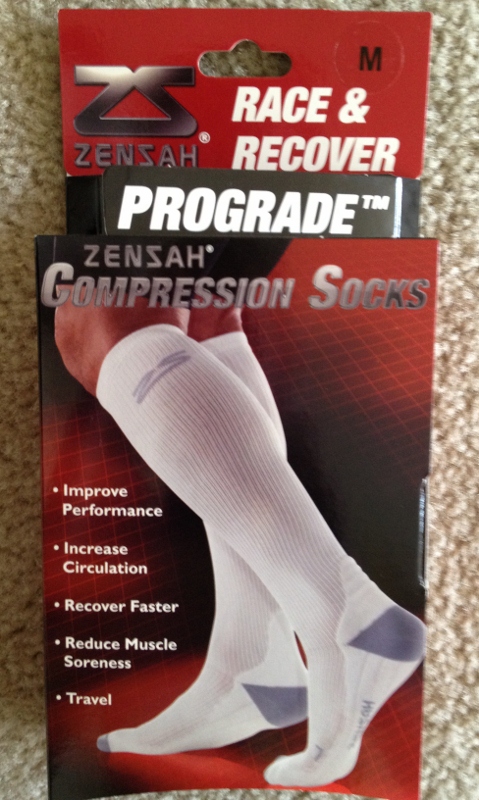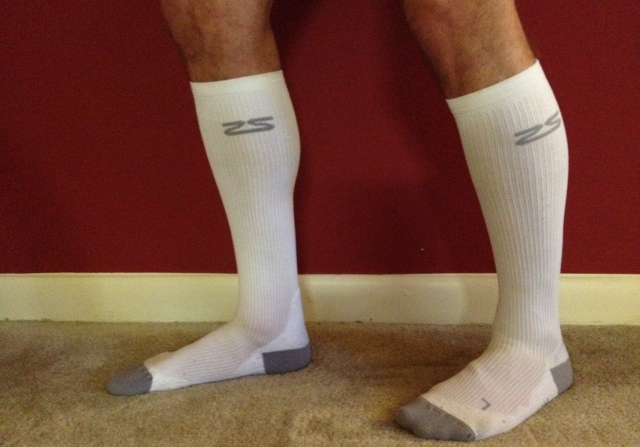A year ago I asked myself, “Do compression socks actually work?” Today, I know the answer.
Whether you use compression sleeves or socks, this post will help you use them as effectively as possible. They both work (and they both look goofy…).

I’m naturally skeptical of new things, especially if they have fantastic claims like some companies make. But after a year of research and testing I’m confident that compression gear does help your running.
I got a pair of Vitalsox compression socks for Christmas in 2010. Eager to test them, I started wearing them for some of my weekly runs.
Honestly, I didn’t notice much of a difference.
Then a year ago I reviewed a pair of CEP calf compression sleeves which I loved and still use to this day. But when I started, I wasn’t using them to their full potential.
Just like any tool in your training and recovery arsenal, there are good ways to use compression socks and even better ways to maximize their impact on your running. Today I want to go over some of the “compression best practices” that you can use in your training to get everything you can out of your compression gear.
Do they actually work?
This section could easily be an entire book, and others have discussed the hard science a lot better than I have, so I’ll be brief. There are several studies that have found they improve performance and recovery:
- This study showed that compression socks improved aerobic and anaerobic threshold
- And another showed that they help you use less energy running at a certain speed (less effort, more speed = win)
- Recovery is less clear. Two studies (here and here) showed no physical benefits to compression gear, but the runners reported less soreness and that they just felt better for their next workout
- Steve Magness, a coach at the Nike Oregon Project, did a review of several studies that showed enhanced muscle recovery after running. See his review here.
Magness goes on to conclude:
There seems to be a bit more consistent effect demonstrated on decreasing muscle soreness and thus enhancing recovery in a wide variety of groups.
Based on my own experience, I think compression socks are best used for recovery and less so for performance improvement. You probably won’t find me running a race in them – though I’d definitely consider it for very long races like a marathon or ultra.
When is the best time to wear compression socks?

Zensah Sizing Information
Like I mentioned, I’m not convinced that compression socks improve performance despite some of the studies mentioned above. The studies are all very different in every respect – different populations of runners, types of runners, fitness levels, etc.
I very rarely wear them during a workout because I like to feel as light and free (naked?) as possible. Instead, I save them for when they’re most useful: after the workout.
When you do a long run or a fast workout on the track, you do a lot of damage to your muscles. Wearing compression socks can help you recover by increasing blood flow in your lower legs when you’re sitting around after that workout. I’m actually wearing my Zensah socks right now as I type this!
Have you ever finished a workout and later in the day your legs feel heavy, dead, or stiff? To help with those feelings, use these recovery strategies:
- After your workout (hopefully you’ll take a shower), put on a pair of compression socks for the rest of the day.
- If you need extra recovery, I’ve found that sleeping in them helps a lot.
Compression socks can help remedy that heavy feeling by improving blood flow while at rest (like when you’re sitting down at work after a morning workout), which will help move byproducts from exercise from your lower legs. Easy cross training like pool running can help you recover the same way.
Zensah Compression Socks Review

Zensah was kind enough to send me a pair of compression socks to review. As you can see from the model above (ok fine, it’s just me), they’re your standard white socks with a padded bottom, arch support, and each sock is designed to fit either your left or right foot. I wish I knew this before I put them on for the first time.
The box and website claim that these socks use graduated compression – that they’re tighter by the foot and ankle and gradually loosen up near the calf. When you’re buying a pair of Zensah compression socks you definitely want a pair that are graduated because they’re more effective at helping you recover from your hard workouts.
Now with that said, I actually didn’t notice any graduation in the pair I received. I can’t feel it when wearing them and there’s no difference in tightness between the ankle and calf from what I can tell. This is in contrast to the Vitalsox I mentioned before which actually feel a lot tighter near the ankle – and also use more elastic material so you can even see the difference.
Zensah makes it clear on their packaging that more compression doesn’t necessarily mean better performance or recovery. You need the right amount. But what that level is remains a mystery to me and every runner will probably prefer a different amount of compression.
I prefer a tighter sock than Zensah to give me a more supportive “snug” feeling in my feet and lower legs. I like to be reminded that I’m wearing compression socks even if that’s purely psychological.
Aside from the tightness – and I’ll be the first to admit that this could be a purely personal preference since so many others swear by Zensah – I love the socks. The padding at the bottom isn’t too thick and gives you a good amount of cushioning without feeling like you’re running on a pillow. I prefer a firm running shoe so the two were a good combination.
So while I may prefer a more snug sock than the Zensah compression socks, I’ll definitely still be wearing them. Having two pairs with different levels of compression allows me to alternate between them depending on what I need. And the more I run barefoot and in racing flats, the more I need better recovery!
If you’re interested in testing a pair for yourself, the best price I could find is on Amazon right here.